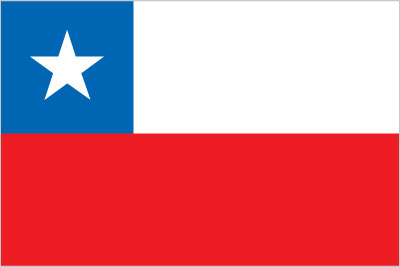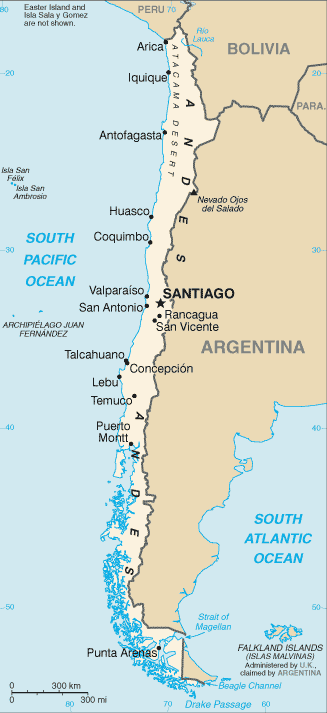Importing from Chile


Chile Country Profile
Official Name (Local Language) República de Chile
Capital Santiago
Population 17,650,114
Currency Chilean Peso
GDP $234.9 billion
Languages Spanish
Phone Dial In 56
Chile Exports Profile
Exports ($m USD) 69,229
Number of Export Products 3,670
Number of Export Partners 181

Chile Economic Statistics
Government Website | https://www.gob.cl/ |
| Sovereign Ratings | https://countryeconomy.com/ratings/chile |
| Central Bank | Banco Central de Chile |
| Currency USD Exchange Rate | 673.2 |
| Unemployment Rate | 7% |
| Population below poverty line | 14.4% |
| Inflation Rate | 4.1% |
| Prime Lending Rate | 3.35% |
| GDP | $234.9 billion |
| GDP Pro Capita (PPP) | $44,000 |
| Currency Name | Chilean Peso |
| Currency Code | CLP |
| World Bank Classification | High Income |
| Competitive Industrial Performance | 33/138 |
| Corruption Perceptions Index | 26/180 |
| Ease of Doing Business | 56/190 |
| Enabling Trade Index | 21/136 |
Access trade, receivables and supply chain finance
We assist companies to access trade and receivables finance through our relationships with 270+ banks, funds and alternative finance houses.
Get StartedImporting from Chile
As a net exporter, Chile’s economy is highly dependent on trade, which makes up over three quarters of its GDP. Chile’s main export is copper, of which it is the world’s main producer; other important exports are carbonates, fruits, and fish. Chile’s most important export destination is China, followed by the US, South Korea, and Brazil. The country has a significant mining industry, producing a significant portion of the world’s lithium as well as copper. Much of the copper exported goes to China, although the US and Canada are also significant destinations. After a few years of lacklustre growth, government investment has caused production to rise, with the next few years seeing record production, which will in turn mean increased exports.
The US and Saudi Arabia are also looking into investing in Chile’s mining sector, drawn by the country’s large reserves and business-friendly government. Despite frequent earthquakes near mining sites, the industry has been resilient and is expected to remain an important part of Chile’s economy for years to come. Chile’s energy sector is also expected to grow as foreign investors fight over the country’s green energy resources, such as hydrogen and wind turbines. In pursuit of carbon neutrality by 2050, the government is focusing on green energy sources, especially hydrogen production; because of the sparsely populated and windy areas to the south, and the ample access to the sea, investment from countries working to meet their own carbon targets is rising. Accordingly, Chile is expected to become an important energy exporter in the next decades as its hydrogen is transported worldwide.
Domestically, Chile is a peaceful country with a long-standing democratic tradition. Protest movements in 2019 over inequality and a dictatorship-era constitution led to unrest and instability, but the situation has since settled and there have been no further flare ups since then.
Importing from Chile: What is trade finance?
In a report presented by the Banco Central de Chile, the country averaged $2,755.71 million from 1991 until 2016 in terms of imports. The imports’ lowest point was $492.60 million in February 1991 and the highest point was reached in October 2012 at $7,875.12 million. On average, Chile’s imports from 1991 until 2016 is $2,755.71 million.
Chile’s primary import commodities are composed of petroleum products and fuel at 13% of the total imports, 7% comprising machinery and parts and cars, computers, mobile phones with 10%, chemicals made up 6% and metal products at 5%.
Out of all Chile’s major import partners, China and the United States both receive 20% of the total imports, Brazil obtains 9%, while Argentina, South Korea and Germany at 4% each.
Chart Showing GDP Growth Compared to rest of world
GDP Composition for Chile
Agriculture
4%
Grapes, apples, pears, onions, wheat, corn, oats, peaches, garlic, asparagus, beans; beef, poultry, wool; fish; timber
Industry
32.4%
Copper, lithium, other minerals, foodstuffs, fish processing, iron and steel, wood and wood products, transport equipment, cement, textiles
Services
63.6%
Map
Top 5 Exports Partners
| Country | Trade | % Partner Share |
| China | 19,091 | 27.58 |
| United States | 9,997 | 14.44 |
| Japan | 6,445 | 9.31 |
| Korea, Rep. | 4,286 | 6.19 |
| Brazil | 3,440 | 4.97 |
Top 5 Exports Products
| Export Product | Number |
| Copper ores and concentrates | 25.1% |
| Copper cathodes and sections of cathodes unwrou | 21.3% |
| Copper unrefined, copper anodes for electrolyti | 3.8% |
| Wine (not sparkling); grape must with by alcoho | 3.8% |
| Fresh grapes | 3.5% |
Local Partners
- All Topics
- Chilean Trade Resources
- Export Finance and ECA Topics
- Local Conferences



















